

MicroRNA-17-92 cluster is a direct Nanog target and controls neural stem cell through Trp53inp1 : Article : The EMBO Journal. Introduction Nanog encodes a homeobox transcription factor expressed in the inner cells of blastocyst (ICM), as well as in the embryonic stem (ES) and in germline cells (Chambers et al, 2003; Mitsui et al, 2003).
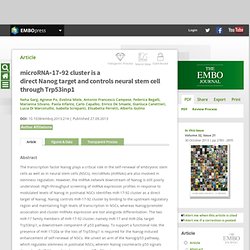
Nanog has been reported to belong to a ‘core program’ of so‐called 'stemness genes’, also conferring cytokine‐independent (e.g., LIF, BMP, and GDF) self‐renewal to ES cells (Mitsui et al, 2003). As a part of such a program, Nanog transcription is modulated by a variety of transcription factors involved in stemness (e.g. FoxD3, Oct4/Sox2, Zfp143, TCF3, p53 and the Hedgehog (Hh) pathway effector Gli1), which bind to its proximal promoter region (Pan and Thomson, 2007; Chen et al, 2008a, b, 2008b; Po et al, 2010).
A role for Nanog has also recently been described in postnatal cerebellar neural stem cells (NSCs), where Hh/Gli‐dependent Nanog overexpression sustains self‐renewal (Po et al, 2010; Zbinden et al, 2010). RNAtomy of the Spliceosome/'s heart : Article : The EMBO Journal. In his 1543 monumental work De humanis corpori fabrica, Andreas Vesalius used rigorous dissection practices and a mechanistic view of the organ's function to provide the first accurate anatomical description of a human heart.
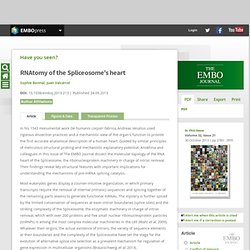
Guided by similar principles of meticulous structural probing and mechanistic explanatory potential, Anokhina and colleagues in this issue of The EMBO Journal dissect the molecular topology of the RNA heart of the Spliceosome, the ribonucleoprotein machinery in charge of intron removal. Their findings reveal key structural features with important implications for understanding the mechanisms of pre‐mRNA splicing catalysis.
Most eukaryotic genes display a counter‐intuitive organization, in which primary transcripts require the removal of internal (intronic) sequences and splicing together of the remaining parts (exons) to generate functional mRNAs. Lncing protein translation to metastasis : Article : The EMBO Journal. Long noncoding RNAs (lncRNAs) are a novel class of regulators that play crucial roles in development and disease.
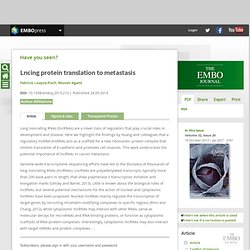
Here we highlight the findings by Huang and colleagues that a regulatory lncRNA (treRNA) acts as a scaffold for a new ribonucleic protein complex that inhibits translation of E‐cadherin and promotes cell invasion. This work underscores the potential importance of lncRNAs in cancer metastasis. Genome‐wide transcriptome sequencing efforts have led to the discovery of thousands of long noncoding RNAs (lncRNAs). The Yin and Yang of enhancer-like RNAs : Article : The EMBO Journal. Functional determinants of the quorum-sensing non-coding RNAs and their roles in target regulation : Article : The EMBO Journal.
Introduction Quorum sensing is a cell‐to‐cell communication process that bacteria use to monitor changes in cell‐population density.
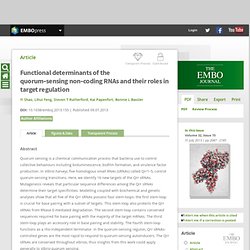
By producing, releasing, and detecting extracellular signal molecules called autoinducers, bacteria transition between individual and group behaviours. Quorum sensing ensures that bacteria execute collective behaviours such as bioluminescence, biofilm formation, and virulence factor production only at appropriate cell densities (Waters and Bassler, 2005; Ng and Bassler, 2009; Rutherford and Bassler, 2012).
In the model bacterium Vibrio harveyi, three quorum‐sensing pathways function in parallel (Henke and Bassler, 2004). At low cell density (LCD), the concentrations of the three autoinducers AI‐1, AI‐2, and CAI‐1 are low. The Qrr sRNAs belong to a large group of trans‐encoded regulatory sRNAs in bacteria (Waters and Storz, 2009). In the present study, we identify 16 new mRNA targets of the Qrr sRNAs. Results Figure 1. DNA polymerase [kappa]-dependent DNA synthesis at stalled replication forks is important for CHK1 activation : Article : The EMBO Journal.
Enhancer-derived RNAs: /`spicing up/' transcription programs : Article : The EMBO Journal. Circular RNAs: splicing/'s enigma variations : Article : The EMBO Journal. CRISPRs extending their reach: prokaryotic RNAi protein Cas9 recruited for gene regulation : Article : The EMBO Journal. A Cas protein from the CRISPR defence system against foreign DNA, also functions in endogenous gene regulation.
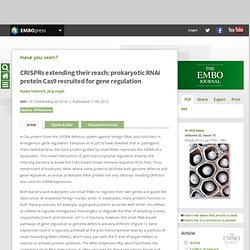
Sampson et al (2013) have revealed that in pathogenic Francisella bacteria, the Cas9 protein guided by small RNAs represses the mRNA of a lipoprotein. This novel mechanism of post‐transcriptional regulation enables the infecting bacteria to evade the TLR2‐based innate immune response of its host. Thus, reminiscent of eukaryotic RNAi where some proteins facilitate both genome defence and gene regulation, a central prokaryotic RNAi protein not only destroys invading DNA but also controls mRNA expression.
Both bacteria and eukaryotes use small RNAs to regulate their own genes and guide the destruction of unwanted foreign nucleic acids. Figure 1. Genome defence and … A DIStinctively novel exoribonuclease that really likes U : Article : The EMBO Journal. A new player in Pol II pausing : Article : The EMBO Journal. Fending for a Braveheart : Article : The EMBO Journal. The rough endoplasmatic reticulum is a central nucleation site of siRNA-mediated RNA silencing : Article : The EMBO Journal. Chaperoning RNA Polymerase II through repressive chromatin : Article : The EMBO Journal.
Struggling to let go: a non-coding RNA directs its own extension and destruction : Article : The EMBO Journal. In addition to its role in DNA‐dependent transcription, RNA polymerase II (Pol II) possesses RNA‐dependent RNA polymerase (RdRP) activity (Lehmann et al, 2007).

In a study published in this issue of The EMBO Journal, Wagner et al (2013) report the first native cellular function of the RdRP activity of Pol II. The authors find that a mammalian non‐coding RNA (ncRNA) can serve as a template for its own extension by Pol II, resulting in its destabilization and a decrease in its potency to repress Pol II. Genome‐wide RNA profiling has demonstrated that approximately three quarters of the human genome are transcribed (Djebali et al, 2012; Pennisi, 2012), leading to a widespread formation of ncRNA since protein‐coding genes account for only 3% of the genome. ncRNAs are predominantly localized in the cell nucleus and are generally expressed at lower levels than protein‐coding transcripts (Djebali et al, 2012). One such ncRNA that regulates transcription is mouse B2 RNA. Figure 1. 3[prime]-UTRs as a source of regulatory RNAs in bacteria : Article : The EMBO Journal. Che-ating death: CHE1/AATF protects from p53-mediated apoptosis : Article : The EMBO Journal.
Using a phospho‐proteomic screen for novel proteins that regulate the DNA damage response (DDR) pathway, the authors discovered MRLC3, a cytoskeletal protein that bound strongly to peptide sequences resembling the phosphorylation motifs of DDR targets, but only when the peptide was in the unphosphorylated form.
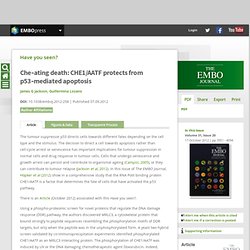
A yeast two hybrid screen validated by co‐immunoprecipitation experiments identified phosphorylated CHE1/AATF as an MRLC3 interacting protein. The phosphorylation of CHE1/AATF was induced by UV or the DNA damaging chemotherapeutic agent Doxorubicin. Indeed, CHE1/AATF shuttled from the cytoplasm to the nucleus in cells exposed to UV or hyperosmotic stress in a phosphorylation‐dependent manner. The finding that the MRLC3–CHE1/AATF complex is cytoplasmic before DNA damage and CHE1/AATF translocates to the nucleus after DNA damage, suggests that the DDR kinase responsible for the phosphorylation is cytoplasmic.
Figure 1. Birthing histone mRNAs by CSR-1 section : Article : The EMBO Journal. The RNA-binding E3 ubiquitin ligase MEX-3C links ubiquitination with MHC-I mRNA degradation : Article : The EMBO Journal. MicroRNA regulation of cancer-endothelial interactions: vesicular microRNAs on the move[mldr] : Article : The EMBO Journal. Molecular mechanisms that enable cancer cells to recruit endothelial cells are intensely studied.
![microRNA regulation of cancer-endothelial interactions: vesicular microRNAs on the move[mldr] : Article : The EMBO Journal](http://cdn.pearltrees.com/s/pic/th/endothelial-interactions-81781671)
Zhuang et al (2012) in this issue of The EMBO Journal describe a new mode of communication between cancer cells and endothelial cells that drives endothelial migration. The authors characterize a small non‐coding RNA (microRNA‐9) that transfers information from cancer to endothelial cells. This microRNA is transported to endothelial cells in microvesicles, functionally facilitating angiogenesis and tumour growth. There is an Article (August 2012) associated with this Have you seen?. Tumours require the establishment of vasculature for their increasing nutrient, energy, and oxygen requirements as well as for removal of metabolic waste. Figure 1. Codanin-1, mutated in the anaemic disease CDAI, regulates Asf1 function in S-phase histone supply : Article : The EMBO Journal. Transcription: another mark in the tail : Article : The EMBO Journal. The three eukaryotic RNA polymerases (RNAPI, RNAPII, and RNAPIII) have a very similar overall configuration and even share several subunits.

The two largest subunits, which together form the active sites of the respective enzymes, are also highly related (Cramer et al, 2008). However, one feature in particular sets the mRNA‐producing polymerase, RNAPII, apart from its relatives: its C‐terminal domain (CTD). Even though the CTD is dispensable for in vitro transcription using purified transcription factors, it plays a crucial role in vivo (Buratowski, 2009; Perales and Bentley, 2009).